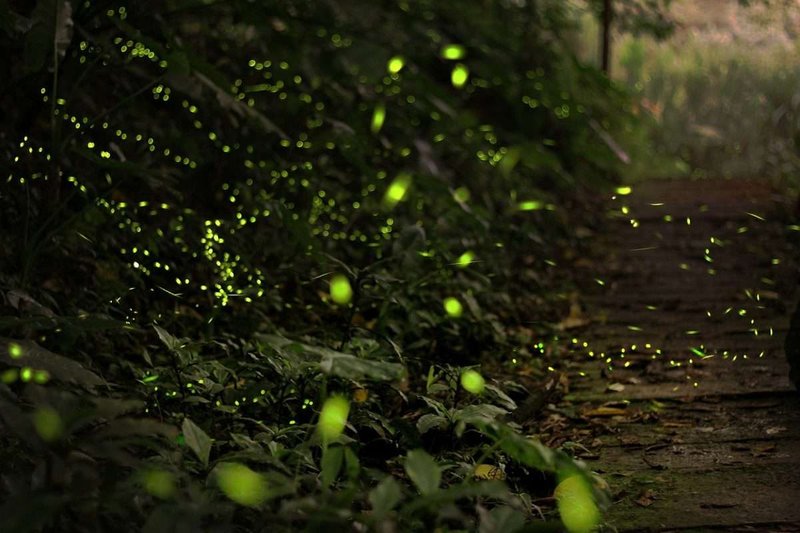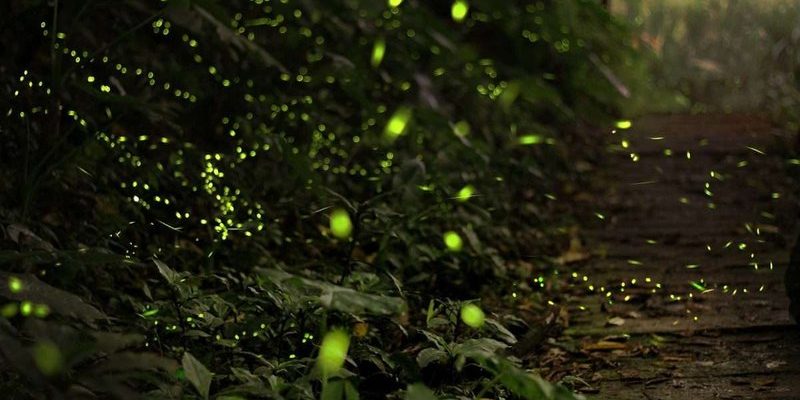
Fireflies, often called lightning bugs, are fascinating little insects that have enchanted many with their magical glow. Imagine you’re outside on a warm summer evening, and the air is filled with the scent of blooming flowers. Suddenly, tiny lights start to flicker in the darkness, creating a dance of natural wonder. That’s the sight of fireflies, whose bioluminescent light has captivated people for generations.
These creatures belong to a family called Lampyridae, which includes about 2,000 species spread across the globe. Contrary to what you might think, the light emitted by fireflies is not a trick of the eye; it’s a real biological phenomenon. Their glow is a result of a chemical reaction in their bodies, specifically in a special organ located in their abdomen. Just picture this: fireflies performing nature’s very own light show, using their glow to attract mates or ward off predators. It’s both beautiful and essential to their survival.
Physical Characteristics of Fireflies
Size and Appearance
Fireflies vary in size, typically ranging from about 5 to 25 millimeters in length. Most have a distinct body shape, which can be a mix of soft curves and angular lines. They tend to have a soft brown or black body, often accented with yellow or orange markings that can make them look almost like tiny gems glittering in the night. It’s these colors that help them stand out against the evening sky.
Interestingly, fireflies undergo a metamorphosis throughout their life cycle. They start as eggs, hatch into larvae, and later become pupae before emerging as adult fireflies. Each stage has its own unique characteristics. For instance, firefly larvae, often called “glowworms,” also produce light, which can help them deter predators. So, even in their youth, they’re putting on a light show!
Habitat and Distribution
Fireflies are found all over the world, but they tend to prefer humid environments. You might find them in fields, gardens, forests, or near ponds. These habitats provide the perfect backdrop for their mating rituals, as the damp air can help carry their light signals over longer distances. The world is home to various species that adapt to different climates—from the tropics to temperate zones—making fireflies a diverse group.
Many outdoor enthusiasts seek out fireflies during the warmer months, as they often create magical displays in backyards or wooded areas. Seeing them in action can feel like stepping into a fairy tale. However, their populations have been declining in some areas due to habitat loss, light pollution, and climate change. This makes it even more important for us to appreciate and protect these enchanting insects.
Life Cycle of a Firefly
The life cycle of a firefly is a captivating journey that lasts anywhere from a few months to a year, depending on the species. It begins when a female lays her eggs in moist soil or leaf litter. These eggs hatch into larvae, which feed on soft-bodied insects, snails, or even other firefly eggs. This predatory nature helps keep their numbers in check while allowing them to grow stronger.
As larvae mature, they eventually enter the pupal stage, where they undergo significant transformation. It’s during this time that they prepare for their final form. Once they emerge as adult fireflies, their primary goal is to mate. This is when the real magic happens, as they light up the night sky in search of partners. The enchanting glow that we see is their way of signaling others. Isn’t it amazing how life continues in cycles?
How Do Fireflies Produce Light?
The glow of a firefly is a captivating phenomenon known as bioluminescence. This occurs through a chemical reaction that involves a light-emitting pigment called luciferin and an enzyme called luciferase. When oxygen combines with these substances in the presence of other molecules, a glowing light is produced. What’s truly fascinating is that this process generates very little heat, which is why it’s often referred to as “cold light.”
Fireflies control their light through a series of intricate patterns. While some species may emit long, steady glows, others might flicker rapidly or produce distinct patterns. This variety helps them communicate during mating rituals. If you’ve ever watched them and thought they were sending you secret signals, you might not be far off! Each pattern can convey different messages, making fireflies not just beautiful but also intricately social.
Fireflies and Their Role in the Ecosystem
Fireflies play an important role in their ecosystems as both predators and prey. As larvae, they help keep pest populations in check by feeding on soft-bodied insects. This natural pest control can be beneficial for gardens and crops, helping to reduce the need for chemical pesticides. In this way, fireflies contribute to a healthy balance in nature.
On the flip side, fireflies also serve as food for various animals. Birds, bats, and other insects enjoy munching on these glowing delicacies. This interconnectedness emphasizes the importance of maintaining firefly populations; if they decline, it can impact the species that depend on them for food. Nature truly is a web of life!
Firefly Conservation
Sadly, fireflies face threats to their populations, primarily due to habitat destruction and light pollution. As cities grow and outdoor spaces become more developed, fireflies lose their natural habitats—the areas they depend on for breeding and feeding. Additionally, the bright lights of urban environments can disrupt their mating signals, making it harder for them to find partners.
Protecting fireflies is essential not just for their survival but for the health of our ecosystems. Simple steps can be taken at the individual level, such as reducing outdoor lighting, planting native plants, and creating more green spaces. You might even consider leaving a patch of your garden wild. These tiny actions can create a safer haven for fireflies and allow the next generation to experience that magical glow.
Fireflies in Culture and Mythology
Fireflies have captured the imagination of cultures worldwide, inspiring myths, stories, and art. In some traditions, they represent hope and inspiration, illuminating our darkest moments. This is evident in literature and folklore, where fireflies often symbolize love or the fleeting nature of life. The beauty of their glow resonates with our deepest emotions, evoking a sense of wonder and nostalgia.
In Japan, for example, fireflies are celebrated in poetry and festivals, reminding people of nature’s beauty and the changing seasons. Their delicate flicker has become a symbol of summer nights, creating a nostalgic feeling for many. Such cultural significance highlights not just the biological aspects of fireflies but their ability to connect us to nature and each other.
Interesting Facts About Fireflies
| Fact | Description |
| Species Diversity | There are about 2,000 species of fireflies worldwide. |
| Life Span | Most fireflies live for a few months; some species can live up to a year. |
| Predatory Larvae | Firefly larvae are predatory and feed on soft-bodied insects. |
| Mating Signals | Their light patterns are used for attracting mates. |
| Cold Light | Fireflies produce cold light through a chemical reaction. |
| Habitat Loss | Urban development and light pollution threaten their populations. |
| Symbolism | Fireflies often symbolize hope and inspiration in various cultures. |
FAQ
Are all fireflies bioluminescent?
Not all fireflies produce light. While most species are known for their bioluminescent capabilities, some do not emit light at all. This lack of luminescence usually relates to their specific life cycle or environmental adaptations. It’s quite fascinating how evolution plays a role in these differences!
Do fireflies bite or sting?
Fireflies are harmless and do not bite or sting humans. They may look intimidating with their glowing bodies, but they generally pose no threat. Their primary goal is to find mates and breed, not to interact with us. So, feel free to enjoy their glow without worrying about getting bitten!
What do fireflies eat?
Adult fireflies primarily feed on nectar, while their larvae are predatory, feeding on soft-bodied insects. The adult fireflies use their lovely glow to attract mates but also benefit from access to food sources like flowers while they’re at it. It’s all part of the circle of life!
How can I attract fireflies to my garden?
To attract fireflies, create a welcoming environment. Leave parts of your garden wild, plant native flowers, and avoid using pesticides. You might also consider adding a small water source, like a birdbath or pond, which can provide a habitat for fireflies. Patience is key, as it might take some time for them to discover your garden!
Why do fireflies glow at night?
Fireflies glow primarily for mating purposes. Males flash their lights to attract females, while females respond with their own light patterns. This beautiful dance helps them find each other in the dark. The night sky becomes their stage for romance, showcasing nature’s enchanting moments!
Can fireflies survive winter?
Yes, fireflies can survive winter in their larval or pupal stages. Depending on the species, some may enter a dormant state until warmer temperatures return. This stage allows them to endure cold conditions while ensuring their survival until spring arrives, when they can resume their life cycle.
Do fireflies only exist in summer?
While summer is when we commonly see fireflies, their presence can vary by region. Some species may emerge in late spring, while others may be around until early fall. Their peak activity often coincides with warm, humid nights, making summer the ideal time to catch their stunning display.
What’s the difference between fireflies and lightning bugs?
There’s no actual difference between fireflies and lightning bugs—both terms refer to the same creatures within the Lampyridae family. The term “firefly” is more commonly used in the United States, while “lightning bug” might be more popular in other regions. Regardless of what you call them, their glow is what truly captivates us!
Are fireflies endangered?
While not classified as endangered, many firefly species are experiencing population declines due to habitat loss, light pollution, and climate change. Researchers are actively studying these trends, as preserving fireflies contributes to healthy ecosystems. Protecting their habitats will help ensure that future generations can enjoy their mesmerizing displays.
Can I use fireflies in crafts or decorations?
While fireflies are enchanting, it’s important to avoid using them in crafts or decorations. Collecting them can disrupt their populations and habitat. Instead, consider capturing their beauty through photography or art that represents their magical glow without harming them. This way, you can enjoy their beauty while helping to conserve their presence in nature!
How long do fireflies live?
The lifespan of fireflies can vary widely depending on the species. Adults typically live a few months, while some larvae can live for several months or up to a year before they emerge. The many stages of their life cycle contribute to their fascinating existence; they go through various transformations before they light up the night!

